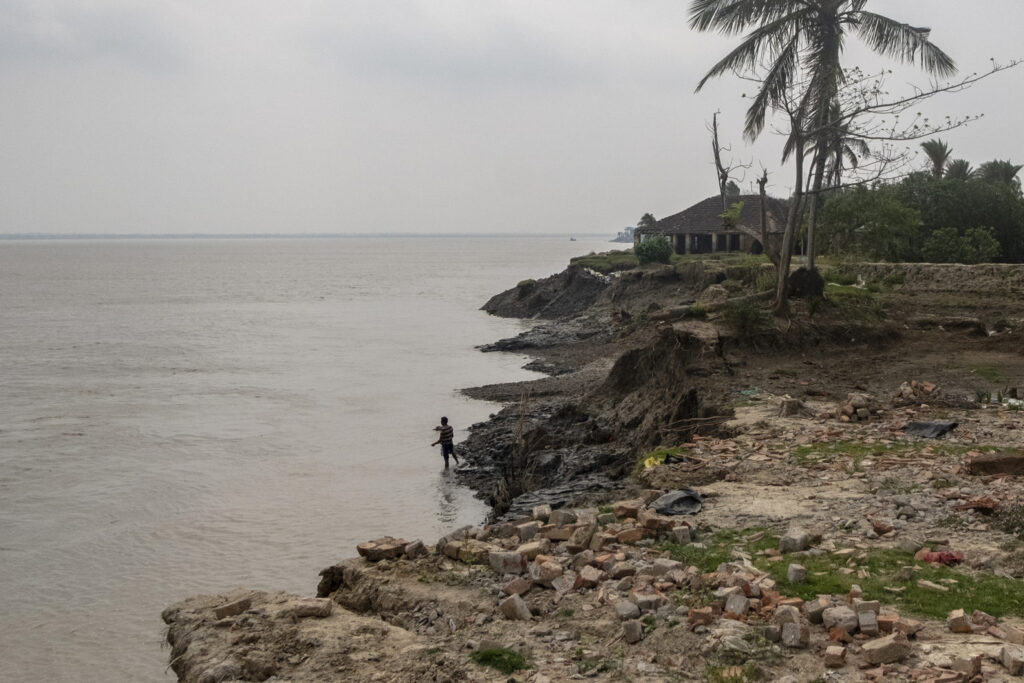Using Art And Song To Bring Sundarbans Back From The Brink
Dec 10, 2022 | Pratirodh Bureau
Sundarbans inhabitants have faced climate-induced displacement for decades. There have been several waves of migration within the Sundarbans, often on the same island, to avoid flooding from embankment breaches, tidal bores and storm surges (Photo by Subhrajit Sen/Mongabay)
Located in the low-lying islands in the Bay of Bengal, the Sundarbans straddle the border between India and Bangladesh and cover more than 1 million hectares, making them the world’s largest single contiguous mangrove swamp. A Ramsar site added to the UNESCO World Heritage list in 1987, they are home to a wide range of critically endangered fauna, including the Bengal tiger, the Ganges dolphin, river terrapin, the estuarine crocodile and the Indian python, along with approximately 428 species of birds, 120 fish, 42 mammal, 35 reptile and 8 amphibian species. Having adapted to the saline estuarine conditions, more than 60 plant species can be found there.
Historically, cyclones have posed a greater threat in the Bay of Bengal than they do in the Arabian sea, to India’s west. Between 1891 and 2018, there were 520 cyclones in the Bay of Bengal, compared to 126 in the Arabian Sea. On top of sucking up large amounts of greenhouse emissions, mangroves also act as the first line of defence against flooding and erosion by lowering waves and storm surges. Research has shown that mangrove swamps are capable of lessening the impacts of major storms and other natural phenomena, not only in the delta region but also in the nearby cities such as Kolkata.
Environmental Degradation
Unfortunately, mangrove swamps have suffered significant degradation due to human encroachment, illegal logging, and seawater levels, which lead to increasing salinity in the surrounding areas. Approximately 40% of the mangrove cover in the Sundarbans has disappeared over the last 20 years.
While several initiatives have been undertaken to replant mangroves, especially on the inhabited islands, a range of natural and institutional vulnerabilities have left long stretches of riverbanks bare and nearby communities exposed to storms and other natural phenomena. Despite growing awareness, it was only after the deadly cyclones Aila (2009) and Amphan (2020) that communities realised the urgent need to restore an ecological balance and develop resilience. With the help of local activists, the communities have been able to achieve partial success, but they do require more encouragement and support to keep this going and inspire neighbouring communities to take it up as well.
It is at junctures like these where organisations like ours, the Living Waters Museum, play a crucial role in providing not only financial assistance but also leading capacity-building activities with youth. Established in 2017, we are a virtual repository exploring the multifaceted dimensions of water through the use of digital media, storytelling, music, theatre and other forms of art. At the forefront of such initiatives lies the project “Climate Wall”, created in association with US Consulate General Kolkata and led by Sukrit Sen, which helps students understand their environment and its challenges.
As part of the project, a physical climate wall teaches young leaders about the different species of mangroves and helps them develop effective strategies for collecting and growing them in nurseries. Once their roots are long enough to withstand the tidal forces, the seedlings are finally planted on the riverbeds. The virtual wall uses creative arts such as paintings, dance, poetry and music as mediums to raise climate awareness and encourage community members to get involved in local governing bodies for water management.
Building Capacity
The project is based in the Sundarbans village of Hingalganj, at the border between India and Bangladesh. There we are currently working with a local organisation called “Breathing Roots” to help schoolchildren learn about the importance of mangroves as well as growing techniques so that they can withstand tidal pressures. We also discuss ways that students can take action to help mitigate climate impacts and understand how our own lifestyles can contribute to climate change. Workshops over the past year have involved media such as art, dance and poetry. The last stage of this project will include another round of tree planting to reinforce the surrounding areas against future cyclones.
Apart from these, one of the main outcomes of this project will include a Bhatiyali song, a genre of music believed to have originated with boatmen who would compose songs based on their long and lonely journeys and what they learned from their surroundings. Bhatiyali singers have thus been documenting climate change for much longer than conventional researchers, who coined the term climate change only in the late 1970s.
While this genre of music was long neglected by newer generations, the song being written will be composed and sung by our youth partners. The goal is that it will be able to serve as a local medium of interpretation and inspire future generations – they too have much to contribute to the scientific discourse of our current times.
